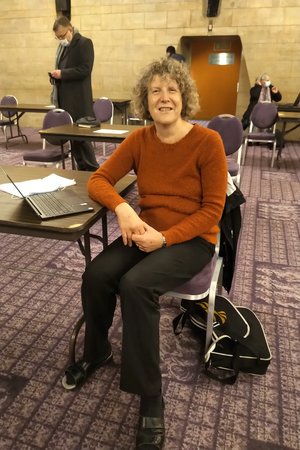Investing in Newcastle's road and pavements - the Liberal Democrats proposals to clear "unacceptable" backlog

In a recent report to Council, Labour's Cabinet Minister acknowledged that the highways network is the most valuable asset of the City Council, that Newcastle currently has a maintenance backlog of £184 million (roads £75 million and footpaths £109 million) and that over 200 streets in Newcastle have more than 80% of the length needing treatment. That is simply unacceptable, Cllr Wendy Taylor from Newcastle Liberal Democrats told a Council meeting on 12th January. (She's pictured just before it started)
We know that the condition of our roads and pavements is a major concern for our residents and that there can be serious health consequences for a frail elderly or disabled resident if they trip or fall due to potholes or uneven pavements and cyclists can also be seriously injured if a pothole causes a fall.
It was also claimed at the October Council meeting that to address the problem of broken pavements and potholes now would bankrupt the City, but that is a ludicrous claim, as other Councils , such as Stockport, Southend and Kent have had very successful capital investments.
Labour also claims that the only solution is for the Government to provide the funds needed, but he knows that will never happen. About 15 years ago, the then Liberal Democrat administration of this Council put forward a well researched and considered bid for funding to the then Labour Government and it was rejected. If Labour Councillors believe this or even a future Labour Government will come to the rescue they are living in cloud cuckoo land.
Of course maintaining good highway condition on 'residential' routes (non-priority) has always been difficult as historically budgets have been steered towards the priority network to improve performance on footway and carriageway condition indicators.
In 2016 the Asphalt Industry Alliance (AIA) survey (an annual independent survey of local authority highways departments in England and Wales) showed that if all authorities were given the budgets required to fix their roads, it would take English Authorities 14 years to catch up with the current backlog.
So how would a capital investment work?
In Stockport, in accordance with the principles of the Council's Transport Asset Management Strategy and Action plan, officers developed a model that was independently verified to consider the whole life costs of maintaining the highway asset. The model demonstrated that a significant investment over a nine year period would provide an appropriate approach to managing the asset.
Subsequently video condition surveys of the highway network were commissioned to develop a detailed understanding of the road and footway conditions and to build a case for a new approach to investment.
In February 2014 Stockport Council's Executive agreed a Highways Investment Programme (HIP) with the aim to improve the% of roads and pavements in the worst category to 10% for carriageways and thereby mitigating the revenue pressures on the reactive maintenance and insurance budgets. They estimated this would require a total capital investment of approximately £100.6m over a nine year delivery period and went ahead with this scheme. The investment is via prudential borrowing
After just 2 years, the % of pavements in the worst category reduced from 37% to 15% and in the last 7 years, Stockport Council has saved over £1, 168, 000 on their highways maintenance budget. The savings are of course not just from reduced repairs being necessary, but from reduced insurance and claim costs and these savings help to fund the loan repayments.
Newcastle Council has a large capital programme and is well used to funding capital schemes via prudential borrowing with loans being payed back over many years. All we are asking for in this motion is for Cabinet to prepare a business case for a capital investment in our roads and pavements with the aim of making them safe for pedestrians, cyclists and motorists and to make a major improvement to our local neighbourhoods.
